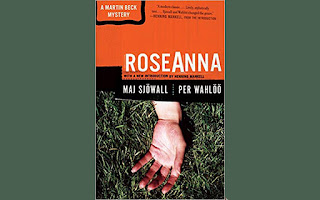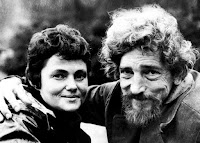by Maj Sjöwall and Per Wahlöö
Crime-solving has changed so radically with technology, linked databases and DNA, that there’s always a risk that older police procedurals won’t age well.
Fortunately, that’s not the case with RoseAnna, even though published in 1965.
As the book opens, First Detective Inspector Martin Beck of the National Swedish Police is called in by colleagues at Motola, about 150 miles southwest of Stockholm on the northern end of Lake Vätrern, to assist in a seemingly impossible case.
A dredge, trying to clear a lock on the lake, pulls up the naked body of a dead woman. She has been strangled and raped. She’s been in the water about four days. The dredge has already dumped several scoops of mud into the center of the lake. She doesn’t match any missing persons descriptions the local police have. Police not only can’t identify the murderer, they can’t identify the victim and have no clues to follow up.
This is a case that requires meticulous police work. Unlike more modern “whizz-bam-kazam” mysteries that pack every scene with heavy action, this one proceeds at a stately pace: detectives take the train to the crime scene or to interview witnesses; information is mailed between continents; international phone calls are short and garbled.
It’s a tribute to the skills of Maj Sjöwall and Per Wahlöö that their story holds your attentions and builds suspense even without fast-paced action. The Martin Beck series was ground-breaking because it was one of the first police procedurals published in Sweden. It presented police work in a realistic, unglamorous way, emphasizing the teamwork rather than a heroic protagonist.
The books in the series that followed RoseAnna (in order) are below. The series ended with Wahlöö’s death just as the last book was going to press.
- THE MAN WHO WENT UP IN SMOKE (1966)
- THE MAN ON THE BALCONY (1967)
- THE LAUGHING POLICEMAN (1968), which won the 1971 Edgar Award for Best Novel
- THE FIRE ENGINE THAT DISAPPEARED (1969)
- MURDER AT THE SAVOY (1970)
- THE ABOMINABLE MAN (1971)
- THE LOCKED ROOM (1972)
- COP KILLER (1974)
- THE TERRORISTS (1975)
About the Authors: Maj Sjöwall (1935 – 2020) and Per Wahlöö (1926 – 1975)
Between 1965 and 1975, Maj Sjöwall and Per Wahlöö wrote 10 books, setting the foundations for Nordic Noir and giving the world the carefully drawn character of Martin Beck and his world.
Sjöwall and Wahlöö were partners in life as well as fiction. They met in the summer of 1962; Wahlöö was married and had a daughter. Sjöwall was the single mother of a six-year-old daughter.
Both were journalists. She had never written a book before; he had been published. Each book took them most of a year to research, plan the plot and draft a synopsis of each book’s 30 chapters. They wrote alternating chapters every evening after their children were in bed.
“They write in long hand, through the night if necessary. One chapter each. The following evening they swap chapters and type them up, editing each other as they go along,” according to Louise France, who interviewed Sjöwall in 2009. Their stories followed the headlines.
In an interview with Richard Shephard, Sjöwall said that their “true subject” was “describing our society and its development during the time period when our books were being written.” She added that they wanted to show Sweden as a welfare state with a hidden “layer of poverty, criminality and brutality” evolving into a “completely capitalistic, cold and inhuman society, where the rich got richer and the poor got poorer.”
The Martin Beck series was praised for its development of character and settings. It influenced authors such as Sweden’s Stieg Larsson and Henning Mankell as well as Scotland’s Ian Rankin.
Each author also wrote other books as well.




